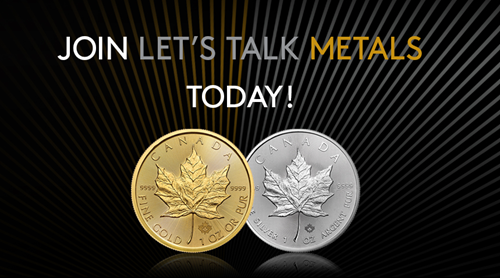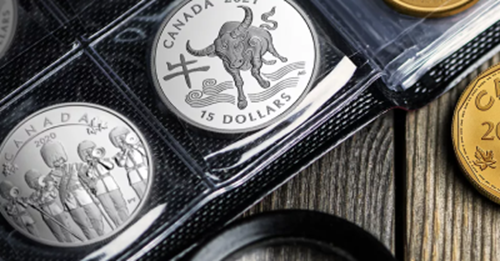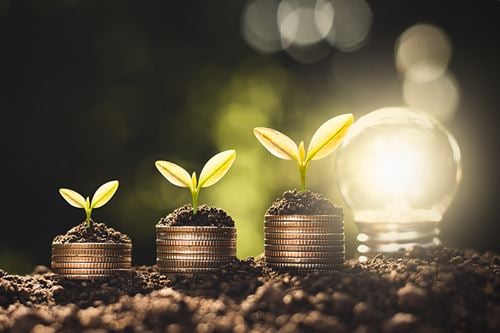Glossary of Gold, Silver and Bullion Terms to Know
- Oct 07, 2022
- Learn
- 10 minute read
Attracted to their beauty, cherished for their symbolism and prized for their historic role as a store of value. These are just a few of the reasons why the world loves precious metals.
Though not abundant in nature, their versatility and use in industrial processes are rich. Precious metals like gold, silver and platinum are known to be rare and to hold great economic value.
Often cast or struck into ingots, bars, wafers or coins, precious metals in bulk form are known as bullion and are traded on commodity markets across the globe. Several nations compete in the minting of gold bullion products, but Canada stands out for having one of the most technically advanced gold and silver refineries in the world!


Two commonly known market conditions are a Bear Market and a Bull Market, and both are defined in our glossary of bullion terms.
Attracted to their beauty, cherished for their symbolism and prized for their historic role as a store of value. These are just a few of the reasons why the world loves precious metals.
Though not abundant in nature, their versatility and use in industrial processes are rich. Precious metals like gold, silver and platinum are known to be rare and to hold great economic value.
Often cast or struck into ingots, bars, wafers or coins, precious metals in bulk form are known as bullion and are traded on commodity markets across the globe. Several nations compete in the minting of gold bullion products, but Canada stands out for having one of the most technically advanced gold and silver refineries in the world!
The first in the world to refine and offer consumers 99.99% pure gold and silver bullion, Canada’s mint was also the first and one of the few to offer gold bullion coins of 99.999% purity.
As much as we love gold and silver, understanding it can be tricky. Especially if you are new to retail bullion. To help you navigate the world of precious metals, here are definitions to some of the most commonly used terms in the industry.
Bullion Glossary
ALLOCATED BULLION OR STORAGE: Bullion products that are owned by an investor and stored in a professional vault, under an arrangement. The bullion products (typically bars or coins) are allocated to a specific account and are uniquely identified.
ASK OR OFFER (PRICE): The price at which a dealer is willing to sell a particular commodity.
ASSAY: The testing of gold or silver to determine its fineness or purity.

BID (PRICE): The price at which a dealer is willing to buy a particular commodity.
BULLION: General term used to describe bars and coins made of precious metals like gold, silver, platinum and palladium. They are coveted for their investment quality, often produced in bulk and required to meet certain international standards for weight and purity, among others.
BULLION COINS: Contemporary precious metal coins minted by official agencies in undetermined numbers for investment purposes. A legal tender coin whose market price depends on its gold content, rather than its rarity or face value.
COMMODITY: A physical product or good which is commonly traded and holds value based on its industrial and commercial value.
Note: A finished product like a bullion coin or bar is not a commodity, in and of itself; however, the gold or silver from which it’s made is.
CORRECTION: A movement in the price of a commodity after a continuous movement in the opposite direction. For example, when the prices in a market constantly rise and then decline.
DORÉ BAR: A bar composed of an impure alloy of precious metals. For example, a gold doré bar is mostly made of gold with a lower percentage of silver. These bars are generally produced by the mine where the metal was sourced and sent to a refinery for further purification.
DIVISIBILITY: How easy it is to piece out and distribute a fixed weight of a certain product.
FINE OUNCE: A troy ounce with a minimum precious metal content of 99.5% pure (minimum fineness of .995). While the LBMA standard for a fine ounce is 99.5%, our standard for a fine ounce of either gold or silver is 99.99% (minimum fineness of .9999).
FINE GOLD: The purity of a gold coin or bullion piece. Pure gold is rated as 24 karats or .999 fine gold.
FINE SILVER: The purity of a silver coin or bullion piece. Pure silver has a .999 fineness or higher.
FINE WEIGHT: The weight of gold or silver contained in a bar, coin or bullion as determined by multiplying the gross weight by the fineness.
FINENESS: The purity of a precious metal measured in 1,000 parts of an alloy: a gold bar of .995 fineness contains 995 parts gold and 5 parts of another metal. For example: a Canadian Maple Leaf has a fineness of .9999, meaning that it is 99.99% pure.
FIX PRICE: A bullion pricing standard which is set every day by the members of the LBMA in London. It serves an international benchmark price for that moment in time and is changed in twice daily for gold and one for silver.
HALLMARK: An official mark (or series of) on a precious metal surface to show the purity and later the producer and serial number.
GROSS WEIGHT: The actual weight of a coin, round or bar.
KARAT: A measure of the proportion of gold in a gold alloy product, on the basis that 24 karats is pure gold. This scale indicates the measurement of purity in gold, from 1 to 24. For example, 10 K (or 10 k) of gold is 10/24 or roughly 41.7% pure gold.

LBMA: The London Bullion Market Association. Formally incorporated 1987 to represent the interests of the participants in the wholesale bullion market.
LBMA GOOD DELIVERY LISTS: Lists of acceptable refiners of gold and silver whose bars meet the required standard (of fineness, weight, marks and appearance) of the London Bullion Market Association.
LIQUIDITY: The ease of buying and selling a certain asset.
MARKET VALUE: The price at which an item trades.
MELT VALUE: The value of precious metal that could be extracted from a product if it were to be melted down. For example, if a coin containing one ounce of silver was melted down and the silver spot price was $20 at that time, then the melt value of that coin is $20.
PHYSICAL MARKET: A marketplace where physical products like bullion are traded. This is opposite of the futures market, where the physical transfer of goods might not happen because only contracts are traded.
PRECIOUS METALS: Metals of great value being gold, silver, platinum and other platinum group metals.
PREMIUM OR MARK-UP: The additional cost for which bullion sells over its bullion value. It represents the cost of distribution, fabrication, and a dealer fee. In general, the premium paid on a small bullion bar or coin is higher than on a large bar.
REFINING: The separating and purifying of precious metals (e.g. gold or silver) from other metals.
ROUNDS: A non-government issued bullion piece or medal.
SCRAP GOLD: The broad term for any gold which is sent back to a refiner or processor for recycling.
SPOT PRICE: Used in commodities trading to denote the live price at which an asset (in an unfabricated form) can be bought or sold for immediate delivered. The spot price is the price required for immediate settlement.
SPREAD: The difference between the selling price and the buying price of a commodity or other trading unit.

TROY OUNCE: The traditional unit of weight that equates to 1.09711 avoirdupois ounce. One troy ounce is a common standard of measurement for precious metals and a standard for pricing and trading bullion. One troy ounce is equivalent to 31.1035 grams, 490 grains or 1.09711 avoirdupois ounces.
Note: The word ounce when applied to gold, always refers to troy ounces.
UNALLOCATED BULLION OR STORAGE: Bullion products that are owned by investors and stored in a professional vault, under an arrangement, but are not allocated to a specific account. The owner holds only the account balance reflected in ounces and not specific or uniquely identified products.
Other Key Financial Terms
BEAR MARKET: A market condition where prices of stocks or other commodities are expected to decline in the near future (historically occurs during a recession). The opposite is the ‘Bull’ market.
BACKWARDATION: A market condition where the spot price for a commodity is seen to be higher than the futures price (historically occurs in markets with supply shortages). The opposite is a ‘Contango’ market.
BULL MARKET: A market condition in which prices are expected to rise in the near future (historically occurs during economic recovery). The opposite is the ‘Bear’ market.
CONTANGO OR FORWARDATION: A market condition where the spot price for a commodity is seen to be lower than the futures price. The opposite is a ‘Backwardation’ market.
EXCHANGE-TRADED FUND (ETF) OR PRODUCT: A type of investment that trades on an exchange. It is similar to a mutual fund in that it contains a collection of different investments (e.g. stocks, commodities, bonds, etc.); however, because it trades like a stock, the price of an ETF will fluctuation.
EXCHANGE-TRADED RECEIPT (ETR): The Royal Canadian Mint’s Gold and Silver Reserves Exchange-Traded Receipts are a type of investment that trades on the Toronto Stock Exchange (TSX). It provides investors with direct ownership in physical gold or silver that is stored in the secure facilities of the Mint.
FIAT MONEY: Paper money that is used as legal tender in a country, though it’s not backed by gold or silver.
HEDGE OR HEDGING: An offsetting transaction (either purchase or sale of an option or future contract) designed to protect from or minimize the impact of unfavorable movements in the assets’ value.
PAPER PRECIOUS METALS: Any precious metal investment that does not result in the investor holding physical gold or silver, for example. Examples include precious metal ETFs, precious metal certificates, etc.



loveGOLD
Gold is all around us. Used in jewellery, technology and as an investment, the demand and different uses for gold are abundant. Discover the special role gold plays in today’s world.


loveSILVER
loveSILVER
Silver is one of the scarcest, most essential and most valuable metals in the world. The industrial usages for silver are rich, driving its demand and appeal as an investment. Silver is precious and here’s why.


lovePLATINUM
lovePLATINUM
Thirty times rarer than gold, platinum is prized in industry and jewellery for its unique properties, and is emerging as an important metal of the future. Along with its diverse applications, investment demand for platinum is growing and here’s why.



